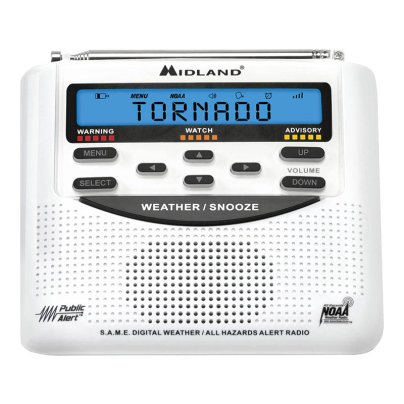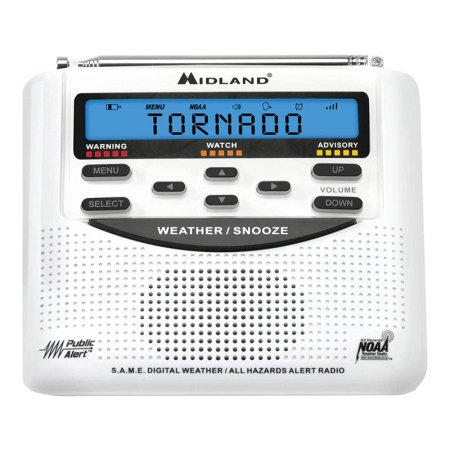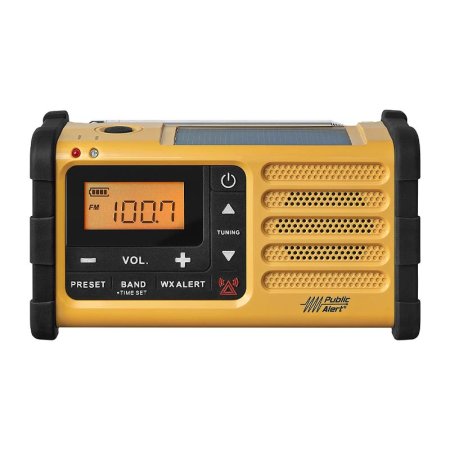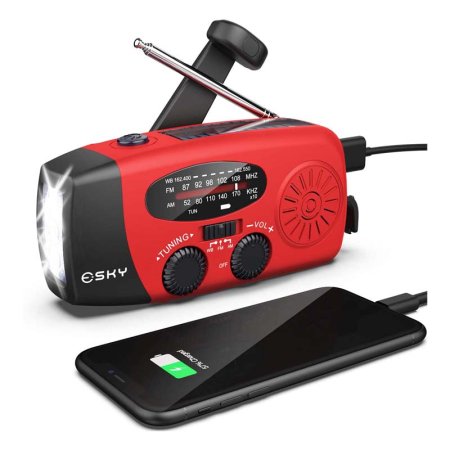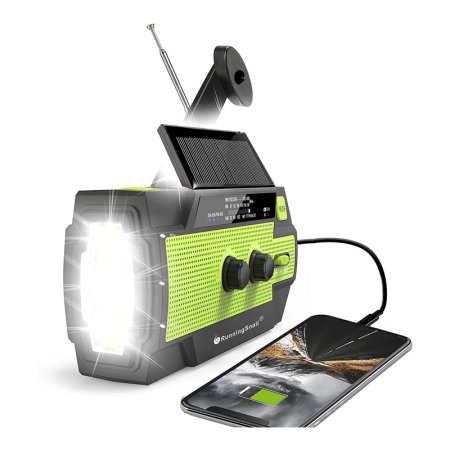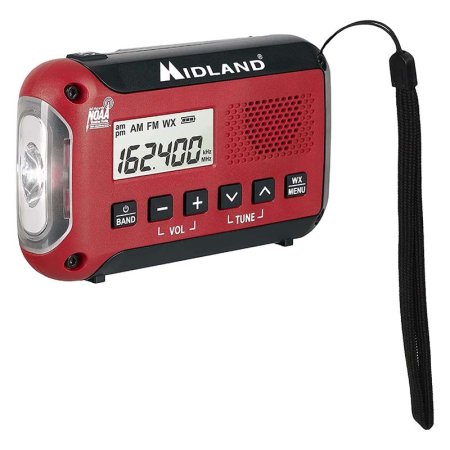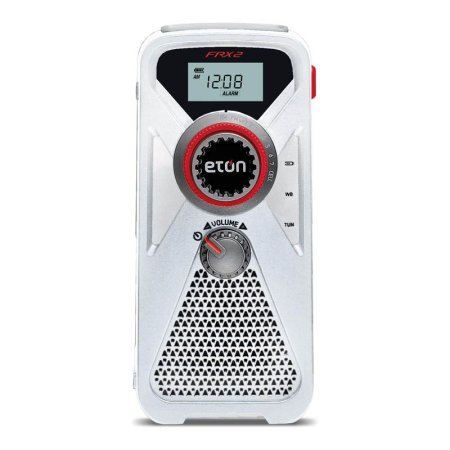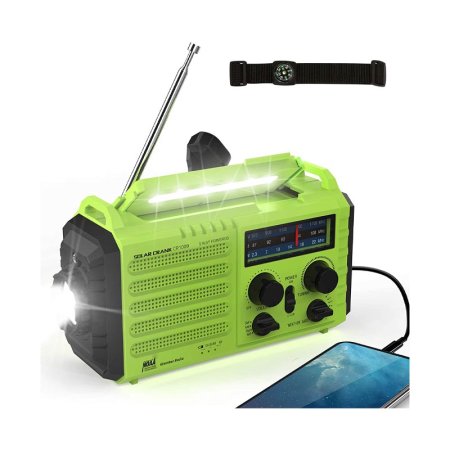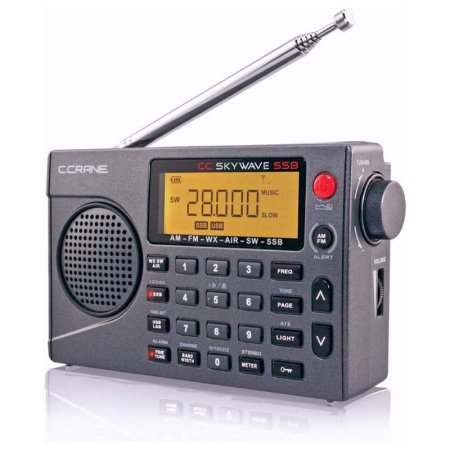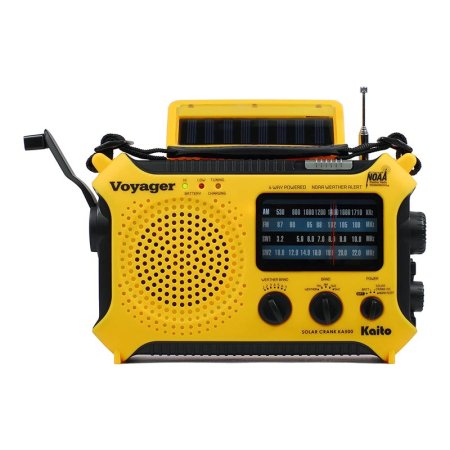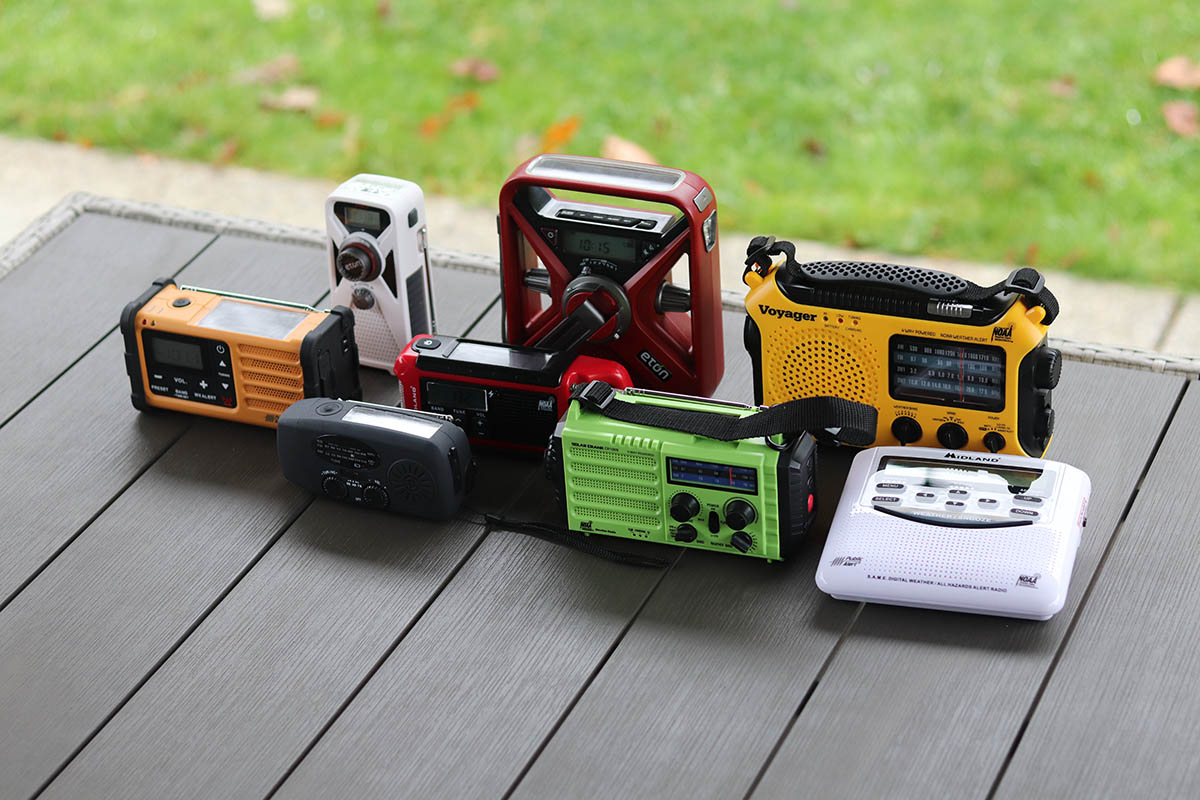
We may earn revenue from the products available on this page and participate in affiliate programs. Learn More ›
Unlike standard radios, emergency radios can receive warnings and notifications from very high-frequency (VHF) public service band stations. Users of emergency radios may listen to dedicated weather channels or set the radio to alert when a weather or disaster warning is issued. Users can access basic AM/FM stations on an emergency radio, too.
Our top choice is the WR120B/WR120EZ from Midland, with several programmable locations and instant weather updates. We took all radios on this list through hands-on testing to see how they work in the field. Everything from the crank and solar panel to the reception was examined in greater detail to make sure we found radios that will perform when the time is right. Whether planning a camping trip or putting together a “just-in-case” kit for the home, everyone should consider including an emergency radio. This guide explains the features to look for and shares some of the best emergency radio options available.
- BEST OVERALL: Midland WR120B/WR120EZ Emergency Weather Alert Radio
- RUNNER-UP: Sangean MMR-88 AM/FM/Weather+Alert Emergency Radio
- BEST BANG FOR THE BUCK: Esky Emergency Hand Crank Radio
- BEST HAND-CRANK: DaringSnail Emergency Crank Radio, 4000mAh-Solar
- BEST COMPACT: Midland ER210 Emergency Compact Crank Radio
- BEST PORTABLE: Eton American Red Cross FRX2 Hand Turbine Radio
- BEST AM/FM: Rocam Emergency AM/FM/SW NOAA Weather Radio
- BEST SHORTWAVE: C. Crane CC Skywave SSB NOAA Weather + Alert Radio
- MOST VERSATILE: Kaito KA500 5-Way Powered Solar Power Emergency Radio
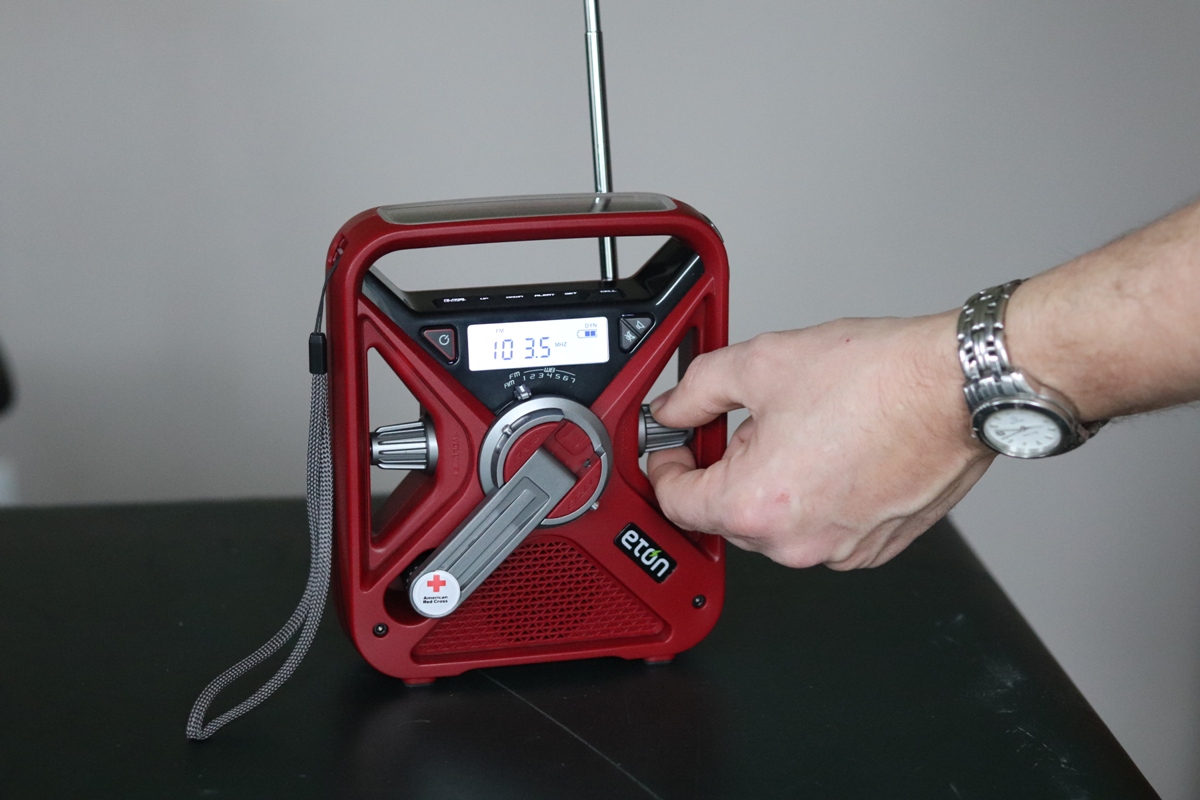
Product Comparison
| Dimensions | Labels | Power Options | |
| Midland WR120B/WR120EZ Emergency Weather Alert Radio | 5.3 inches tall by 6.1 inches wide by 2 inches deep | NOAA | Electricity or battery |
| Sangean MMR-88 AM/FM/Weather+Alert Emergency Radio | 3.29 inches tall by 5.98 inches wide by 0.69 inches deep | Public alert | Battery, DC, crank, solar |
| Esky Emergency Hand Crank Radio | 2.4 inches tall by 5 inches wide by 1.8 inches deep | NOAA | USB, hand crank, solar panel |
| DaringSnail Emergency Crank Radio, 4000mAh-Solar | 3.19 inches tall by 6.23 inches wide by 2.48 inches deep | NOAA | USB, battery, solar panel, hand crank |
| Midland ER210 Emergency Compact Crank Radio | 2.8 inches tall by 6.5 inches wide by 1.9 inches deep | NOAA | USB, battery, hand crank, solar panel |
| Eton American Red Cross FRX2 Hand Turbine Radio | 5.7 inches tall by 4.7 inches wide by 2.8 inches deep | NOAA | USB, battery, solar panel, hand crank |
| Rocam Emergency AM/FM/SW NOAA Weather Radio | 4.7 inches tall by 7.5 inches wide by 3.5 inches deep | SW, NOAA | C, battery, solar panel, hand crank |
| C. Crane CC Skywave SSB NOAA Weather + Alert Radio | 3 inches tall by 4.75 inches wide by 1 inch deep | NOAA, shortwave, VHF airband | 2 AA batteries |
| Kaito KA500 5-Way Powered Solar Power Emergency Radio | 5 inches tall by 8 inches wide by 2.5 inches deep | NOAA, shortwave | AC adapter, battery, USB, solar panel, hand crank |
Our Top Picks
These top picks are emergency radios that can pick up National Oceanic and Atmospheric Administration (NOAA) broadcasts in addition to offering AM/FM listening ability. The best emergency radios also feature more than one power source, such as battery, solar, or hand-crank power, and have clear listening reception.
It’s a bonus if the radio comes with weather-resistant properties and other features. We’ve tested all of the following radios, so we can verify that they do all that’s promised. Check out some of the best emergency radios for use when the power goes out.
Best Overall
Midland WR120B/WR120EZ Emergency Weather Alert Radio
What We Like
- Loud, audible alarm
- Instant weather updates with the tap of a button
- 25 programmable locations
- Ease of use
What We Don’t Like
- No extra features like a flashlight or device charging
- Only 2 charging options
Product Specs
- Dimensions: 5.3 inches tall by 6.1 inches wide by 2 inches deep
- Labels: NOAA
- Power options: Electricity or battery
In addition to its functionality and ease of use, the Midland WR120B/WR120EZ Emergency Weather Alert Radio stands out for being configurable into multiple languages—English, French, and Spanish. It also features 25 programmable locations, so users can check out conditions in other parts of the country if needed or wanted.
The built-in Specific Area Message Encoding (SAME) technology helps ensure that users can always receive alerts specifically pertaining to their home region. There is an option to select a preferred type of alert: a siren alarm, a voice alert, or a flashing LED light. Plug the Midland radio into any standard outlet or power it with two AA batteries.
We can definitely verify that the Midland weather emergency alert radio will alert the listener to impending inclement weather. It was tested in an office space, where we left it plugged in and on. At any time, users could walk past it and hit the weather/snooze button to get an update on the latest weather alerts in their area.
We left it running until one day we randomly heard an alert sound somewhere in the house. It wasn’t until the second warning (and a very startled jump while sitting at our desk) that we realized it was the Midland WR120B/WR120EZ. A small-craft warning in the region was going out due to a severe windstorm moving through the area.
This model is an excellent option for an alarm clock/emergency radio combo. For those who live in an area where tornadoes or other sudden storms come up, this radio will alert them, with instructions, as long as it’s plugged in or has batteries. We also liked that it provided a weather update at any time simply by clicking a button. It doesn’t have the wide range of emergency features like a flashlight or USB charging like some of the other tested models, but for emergency weather situations, this radio will keep users up to date.
Get the Midland WR120B/WR120EZ emergency radio at Amazon or Best Buy.
Runner-Up
Sangean MMR-88 AM/FM/Weather+Alert Emergency Radio
What We Like
- Heavy-duty casing and reinforced corners
- Powerful reception
- Lots of power options
- USB port for charging other devices
What We Don’t Like
- We had to charge the battery upon arrival
- Lack of intuitive controls
Product Specs
- Dimensions: 3.29 inches tall by 5.98 inches wide by 0.69 inches deep
- Labels: Public alert
- Power options: Battery, DC, crank, solar
The Sangean MMR-88 AM/FM/Weather+Alert Emergency Radio comes in a small package, but it’s packed with power. Of all the casings we tested, this one felt the most sturdy and durable, although its heavy plastic and reinforced edges could take a beating if the user were in an emergency weather situation. It has several power options, including a hand-crank generator, a solar charging panel, and DC.
On testing, the rechargeable battery was installed upon arrival. However, the battery was dead when it arrived, so we had to charge it for the first use, and we tried the solar panel in the meantime. The manufacturer recommends using the solar panel only in emergency situations. It’s not really designed to power the radio all the time, and with good reason. It takes 15 hours to charge the battery with sunlight, and it needs to be direct sunlight—very direct.
The Sangean solar panel didn’t charge at all sitting on a windowsill. Using the hand crank for 1 minute, we were able to get about 5 minutes of airtime, which is pretty standard. It only took a couple of hours using a DC charger to get it fully charged. At that point, this model got some of the best reception of any we tested. It helped that it had a longer antenna than most of the other models, too.
One other issue we had was that the controls weren’t intuitive. Buyers will definitely need to spend some time with the manual to make sure they understand how to use everything. Even the labels on the buttons weren’t too helpful in figuring out how to use them.
Get the Sangean emergency radio at Amazon.
Best Bang for the Buck
Esky Emergency Hand Crank Radio
What We Like
- Compact and portable
- Multiple charging options
- Capable of charging phones
- Very affordable
What We Don’t Like
- AM/FM sound quality could be improved
Product Specs
- Dimensions: 2.4 inches tall by 5 inches wide by 1.8 inches deep
- Labels: NOAA
- Power options: USB, hand crank, solar panel
Purchasing an emergency radio for up-to-the-minute information doesn’t have to cost a lot. The Esky Emergency Hand Crank Radio receives AM/FM/NOAA broadcasts and comes with a built-in LED flashlight to get around in low-light situations. The Esky also features a USB port for charging a cell phone, a tablet, or other digital device. The radio operates on a rechargeable 1000-milliampere hour (mAh) lithium-ion battery via three energy sources—an integrated solar panel on the top of the radio, a manual hand crank, and via micro-USB power, so it’s always ready in the event of an emergency.
At just 2.4 inches high and 5 inches wide, this emergency radio is compact enough to fit in a backpack, making it well suited for camping and hiking outings. The low cost makes it an affordable addition to the car or camper. Sadly, the sound the pint-sized radio produces matches its size. It doesn’t provide the best sound, and the dials are a little fiddly to use. They are analogue rather than digital, making it challenging to be accurate when tuning to AM, FM, or the emergency weather station.
What this radio did do was save space and weight. If shoppers are packing light or need a radio for an emergency kit, this one can do it without gobbling up space or budget. That said, there is a lot of plastic, and it isn’t particularly robust. One feature we appreciated in such a small radio was the ability to charge other devices. However, it doesn’t do so particularly quickly, so patience is required. Another happy surprise was the bright flashlight. This little guy could outshine many of the bigger, more powerful radios.
Get the Esky emergency radio at Amazon.
Best Hand-Crank
DaringSnail Emergency Crank Radio, 4000mAh-Solar
What We Like
- Battery-power indicator lights
- Multiple flashlight settings
- Clear radio reception (not weather station)
- Can charge more than 1 phone on a full battery
What We Don’t Like
- Difficult to tune into weather station
Product Specs
- Dimensions: 3.19 inches tall by 6.23 inches wide by 2.48 inches deep
- Labels: NOAA
- Power options: USB, battery, solar panel, hand crank
If the built-in lithium-ion battery in the DaringSnail Emergency Crank Radio runs down, the radio’s hand crank will generate all the energy necessary to listen to weather and news reports and operate the unit’s super-bright flashlight. The radio receives AM/FM and NOAA broadcasts, and it comes with a USB port for charging a cell phone or a tablet.
During testing, the AM/FM reception was exceptionally clear. However, the NOAA broadcasts were much more difficult to find. Yes, we could get on the weather band, but a stiff manual dial made it difficult to tune into a station. The reception for the station we did find wasn’t great. For strictly weather purposes, this model wasn’t the best.
However, there were other features that worked well. It comes with a motion-sensing night light that automatically illuminates with nearby movement, which is a good feature for campers or others who need to get up at night. And the reading light is bright. We would say it was almost blinding, which is effective when out on the trail or camping.
Users can also charge the radio’s battery with its built-in flip-up solar panel on sunny days. The solar panel worked so-so. We got enough of a charge to turn the radio on but had to boost it up with the hand crank. The hand crank helped this model stand out, with a longer handle than average and a smooth cranking action, so it was easy to use. Our favorite feature that had to do with the crank was the four battery-indicator lights that let owners know how much power has been generated.
Get the DaringSnail emergency radio at Amazon.
Best Compact
Midland ER210 Emergency Compact Crank Radio
What We Like
- Small, lightweight size but durable construction
- 3 flashlight settings
- Digital tuning
- Easy-to-use crank that hides in the casing well
What We Don’t Like
- Time-consuming to tune into weather stations
Product Specs
- Dimensions: 2.8 inches tall by 6.5 inches wide by 1.9 inches deep
- Labels: NOAA
- Power options: USB, battery, hand crank, solar panel
The Midland ER210 Emergency Compact Crank Radio comes in a deceptively small size that belies its reception abilities. The AM/FM radio picks up a strong signal, and the speaker provides surprisingly loud audio. The AM/FM radio and the weather radio work with a digital tuner. In some ways, that’s easier to use than a dial, but it takes longer to find stations unless owners already know which one they are headed for.
The radio runs with a USB power cord, a battery, solar power, or by hand crank. The crank is easy to turn and hides well into the casing, creating a smooth outer appearance. Three flashlight settings can come in handy in an emergency situation. It has a (very bright) high beam and a low beam, as well as an SOS signal.
This model automatically locks on to the strongest weather station, but the stations can also be scanned through if needed. An alarm sounds if there’s severe weather predicted in the local area. Overall, it was an easy radio to use once we’d gone through the manual. The digital tuning was easier to use than many of the manual dials on the other models, which was a huge plus.
Get the Midland ER210 emergency radio at Amazon or Best Buy.
Most Portable
Eton American Red Cross FRX2 Hand Turbine Radio
What We Like
- Small and lightweight
- Can charge other devices
- 4 power options
What We Don’t Like
- Difficult to tune into weather stations
- Hard to push flashlight button
Product Specs
- Dimensions: 5.7 inches tall by 4.7 inches wide by 2.8 inches deep
- Labels: NOAA
- Power options: USB, battery, solar panel, hand crank
Slip the Eton radio into a backpack or a duffel bag for easy carrying and retrieval. The radio measures just 5.7 inches high by 4.7 inches inches wide by 2.8 inches deep and weighs less than 1 pound, making it easy to carry, slip into a drawer or glove compartment, or pack in a suitcase. While small in stature, the Eton radio offers a full spectrum of emergency functions, including the ability to receive AM/FM and NOAA broadcasts, so the user will never be far from important information about weather alerts or other emergencies.
The Eton radio comes with a built-in lithium-ion battery charged with a USB charger, an integrated solar panel, and a manual hand crank. The radio also has a headphone jack, a bright LED flashlight, a cell phone charger, and a glow-in-the-dark indicator to make locating the radio easier in the dark.
However, the Eton isn’t the easiest radio to use. The controls are confusing, and the directions don’t help out a lot. It took some work to get it dialed into a weather station. It’s small though, and once the user knows how to use the dials, they can get the information they need. Plus, it can charge other devices when its battery is fully charged.
Get the Eton FRX2 emergency radio at Amazon.
Best AM/FM
Rocam Emergency AM/FM/SW NOAA Weather Radio
What We Like
- Siren-loud SOS signal
- Bright reading light
- Strong reception
- Easy to tune into NOAA
What We Don’t Like
- Reading light doesn’t turn off automatically
Product Specs
- Dimensions: 4.7 inches tall by 7.5 inches wide by 3.5 inches deep
- Labels: SW, NOAA
- Power options: DC, battery, solar panel, hand crank
With its telescoping antenna, the Rocam emergency radio is at the top of its class for picking up a variety of broadcast frequencies, including AM/FM, shortwave, and NOAA broadcasts. The antenna boosts the radio’s range to receive stations at a greater distance than other radios can.
This model got incredible reception and was very easy to tune to NOAA. We could either use a manual dial or a dial that went to each of the seven weather-band stations. We couldn’t tune to a shortwave, but then this was one of the few radios that even had that option.
The Rocam offers a wide range of additional functions, including an earsplitting (seriously earsplitting) SOS signal that will attract attention if the user is in danger, a super-bright LED flashlight (high and low beam), an LED reading lamp, a directional compass, and a cell phone charger. The radio comes with a rechargeable lithium-ion battery but also accepts three AAA batteries, has an integrated solar panel, and also a hand crank.
The reading light’s power matches that of the SOS signal, as in wow, don’t look directly into the light. However, the reading light doesn’t automatically turn off when the light is shut, so it’s easy to leave it on by accident. The radio comes with a detachable carry strap, and the case will resist damage from light rain and high humidity.
Get the Rocam emergency radio at Amazon.
Best Shortwave
C. Crane CC Skywave SSB NOAA Weather + Alert Radio
What We Like
- Multiple reception bands
- Precise digital tuning possible
- Clear and informative display
- Lightweight and compact
What We Don’t Like
- Comparatively expensive
Product Specs
- Dimensions: 3 inches tall by 4.75 inches wide by 1 inch deep
- Labels: NOAA, shortwave, VHF airband
- Power options: 2 AA batteries
The main benefit of shortwave radio, also known as single side band (SSB), is its ability to transmit and receive over long distances, and not just hundreds of miles—but thousands. The CC Skywave radio has the usual AM/FM and NOAA weather alerts but adds the ability to pick up shortwave from both land-based and marine stations, plus VHF aviation bands used by commercial pilots around the world. It can even receive ham radio signals (though it can’t respond to them).
The digital receiver has an auto-scan facility to find stations quickly; then the manual dial can be used for precise tuning. There are 400 memories, a 12/24 hour clock, and an alarm. It all fits within a compact case that measures just 3 inches high by 4.8 inches wide by 1 inch deep, and it weighs only 6 ounces. There is a convenient fold-out stand, and included in the package are earbuds and a 23-foot shortwave reel antenna.
There is no crank handle, solar panel, or charger, which some may see as a disadvantage. However, the CC Skywave will run for up to 60 hours on a pair of ordinary alkaline AA batteries, which are low cost and widely available (though none are included). An AC power adapter can be added, but it costs extra.
Get the C. Crane emergency radio at C Crane.
Most Versatile
Kaito KA500 5-Way Powered Solar Power Emergency Radio
What We Like
- Strong reception
- Multiple lighting options
- Charges other devices
What We Don’t Like
- Difficult to turn on and dial in
Product Specs
- Dimensions: 5 inches tall by 8 inches wide by 2.5 inches deep
- Labels: NOAA, shortwave
- Power options: AC adapter, battery, USB, solar panel, hand crank
The multifunctional Kaito KA500 5-Way AM/FM/SW/NOAA weather alert radio receives the seven NOAA bands and two shortwave bands; this means it offers broadcasts from other countries. Reception quality is high, and the radio has five power options: by hand crank, flip-up solar panel, AC adapter, battery (three nickel metal hydride [NiMH] AA rechargeable batteries), or USB. Those power options are really this model’s strength since users can find a way to charge in most situations.
The Kaito does not disappoint in terms of added features, as it includes a built-in charger for mobile devices, a reading light, a flashlight, and an SOS beacon. However, the Kaito isn’t the easiest radio to use. It has an on/off switch on the front, but that only turns on some of the features.
There’s also a tiny on/off switch hidden with the charging ports that activates everything. The dials themselves are also confusing, so while this is a great radio for all the power options, it’s not the easiest to use.
Get the Kaito emergency radio at Amazon.
Jump to Our Top Picks
How We Tested the Best Emergency Radios
Testing took place in a home office. Surprisingly, many of the radios arrived with dead rechargeable batteries. Our first point of order was charging. Charging with the DC or the USB cords was the fastest way to power, but we also charged using the solar panels and hand cranks.
From there, we tested the reception quality, both with the AM/FM, weather bands, and shortwave radio if the model had it. Ease of use became pretty evident by this point in the testing. Some models were very simple to figure out, while others required carefully going through the owner’s manual.
We tried out all the charging options. With the hand cranks, we timed how long we had to crank to get 5 minutes’ worth of power. We also considered how hard it was to use the crank.
Durability, size, and weight factored into the testing process, too. Some models felt lightweight and cheap, while others were lightweight but still felt like they could withstand some heavy use. Portability came into play with this part of the testing, too. A radio could sit on a nightstand, but others could get tossed into a backpack without adding too much weight.
What to Consider When Choosing the Best Emergency Radio
There are many features to consider when shopping for an emergency radio. Some of the most important include the types of alerts the user can receive, charging options, and whether it can serve other useful functions.
Labels
The first thing many shoppers discover when researching emergency radios is the plethora of labels with acronyms. They can seem overwhelming and downright confusing. However, knowing what each acronym means makes it much easier for shoppers to select the radio that’s right for them. Here’s a rundown of the various letters, logos, and labels buyers are likely to encounter when shopping for an emergency radio.
- NOAA: The NOAA broadcasts on seven dedicated frequencies in the United States and Canada. Emergency radios with the NOAA Weather Radio All Hazards logo are certified to receive alerts from the National Weather Service, the Department of Homeland Security, and from authorized regional Emergency Operation Centers. Look for this logo to ensure the radio will receive the highest number of alerts.
- IPAWS (Integrated Public Alert and Warning System): The IPAWS system, maintained by FEMA (Federal Emergency Management Agency), broadcasts three major types of alerts: imminent threats, presidential pronouncements, and AMBER (missing person) Alerts.
- NWR (National Weather Radio): NWR indicates that the radio can pick up regional stations that broadcast weather-related news 24/7.
- EAS (Emergency Alert System): A radio with EAS receives broadcasts concerning national emergencies and regional warnings, including AMBER Alerts.
- Public Alert: The label “Public Alert” signifies that the radio was developed by the Consumer Electronics
Association in conjunction with the National Weather Service.
While governmental agencies do not endorse any specific manufacturer or brand, they do advise buyers to look for a radio that features both the NOAA All Hazards logo and the Public Alert label.
Charging Options
An emergency radio works when the power goes out. Many emergency radios are multipowered, meaning they feature two or more of the following charging options.
- Battery: This is one of the most common power options for emergency radios, but if the radio is battery-powered only, be sure to keep extra batteries on hand. Battery-powered radios may be compact, such as pocket radios, making them well suited to traveling.
-
Solar: These radios feature solar panels that draw power from the sun’s rays.
Hand crank: Because batteries eventually discharge and solar power may not be available during storms, a hand crank is a wise backup power source. - Car charger: Some radios come with an additional charger that plugs into a vehicle so the device can charge while on the road.
- Standard electrical power: The ability to plug the radio into a standard outlet allows an AC adapter to run the radio when there is power, conserving battery life.
Key Features
Today’s emergency radios are often designed to serve multiple purposes. Use these options judiciously; the features that draw power will shorten battery life.
- Flashlight: Great for those times when a little light is needed during a power outage and there isn’t a regular flashlight.
- Flashing light: Useful for attracting attention when assistance is needed, like when a car breaks down alongside the road.
- Cell phone charger: Includes an auxiliary port for recharging cell phones and tablets.
- Speaker options: Most emergency radios have external speakers that permit anyone in the vicinity to listen, but a unit that allows headphones or earbuds can be helpful in certain situations (such as when children are sleeping nearby).
- Listener language options: Allows for listening to emergency broadcasts in languages other than English.
- Shortwave capability: Some models are capable of receiving shortwave broadcasts. Shortwave stations do not broadcast emergency information and alerts, but users can listen to broadcasts from all over the world.
- Digital clock: Handy for keeping track of time. Some radios also come with alarm clocks.
- Waterproof case: Protects the radio in rainy conditions.
- Impact-resistant case: Lets the radio really take a beating. It’s advisable for anyone who’s butterfingered or tough on gadgets.
Types of Emergency Radios
When it comes to emergency radios, there are two main types to consider.
Weather Alert Radio
Usually using a loud beep or tone, a weather alert radio notifies the user of the presence of imminent bad weather, such as a tornado, a hurricane, an impending winter storm, or even an earthquake. Weather radios broadcast alerts from the NOAA. However, users can zero in on a geographical region of interest, depending on whether it has SAME technology.
- Weather alert radios with SAME: Many of today’s emergency weather radios come with SAME, allowing radio users to block alerts meant for other geographic areas. When the SAME feature is activated, users will only receive alerts concerning their county or nearby counties.
- Weather alert radios without SAME: Users will receive all weather alerts from stations broadcasting within the user’s reception area, including alerts for regions that do not affect the listeners.
AM/FM Radio
The ability to pick up both AM and FM radio frequencies allows up-to-the-minute information on developing situations from both local stations and stations that are farther away. They also can be used to listen to music, making them a versatile addition to a home emergency kit.
The Advantages of Owning an Emergency Radio
A vital addition to any disaster plan, an emergency radio keeps users informed and aware of dangerous situations as they occur. They’re also an essential tool for receiving weather and other information to help keep loved ones and pets safe.
- An emergency radio that picks up NOAA broadcasts will keep users abreast of changing weather situations.
- Most emergency radios will sound an audible tone to alert users to the possibility of a potentially dangerous situation.
- Many of today’s emergency radios come with added features, such as a flashlight or the ability to charge a cell phone.
Tips for Using an Emergency Radio
Purchasing an emergency radio is a step toward protecting loved ones if an emergency occurs. While the hope is that an emergency radio will never be necessary, it can make good sense to plan ahead and be prepared. The following tips will help ensure the radio is ready to go in any situation.
- Store the emergency radio in an airtight, waterproof case, and if it requires batteries, store an ample supply.
- Check the emergency radio to ensure it’s working correctly before taking it on a camping or hiking trip.
- Owners should familiarize themselves with the radio’s functions as soon as possible so they won’t have to take time to read directions if an emergency occurs.
FAQs
Q. What kind of radio is used for emergencies?
One of the most critical functions of an emergency radio is the ability to receive NOAA alerts and broadcasts. Even more important is the ability to operate the radio without electrical power. This means the radio must have another power source, which may be by battery, solar, or hand crank.
Q. When would I need an emergency radio?
An emergency radio is helpful at home if the power goes out so you are able to receive vital information. They also are needed when camping or hiking to stay abreast of local weather conditions.
Q. What is a crank radio?
A hand-crank emergency radio derives power from manually cranking a handle. This type of radio will never run out of power as long as someone is there to turn the handle.
Q. How long do emergency radios last?
An emergency radio can last from 5 to 10 years or longer if it’s kept clean, dry, and is not dropped or otherwise abused.
